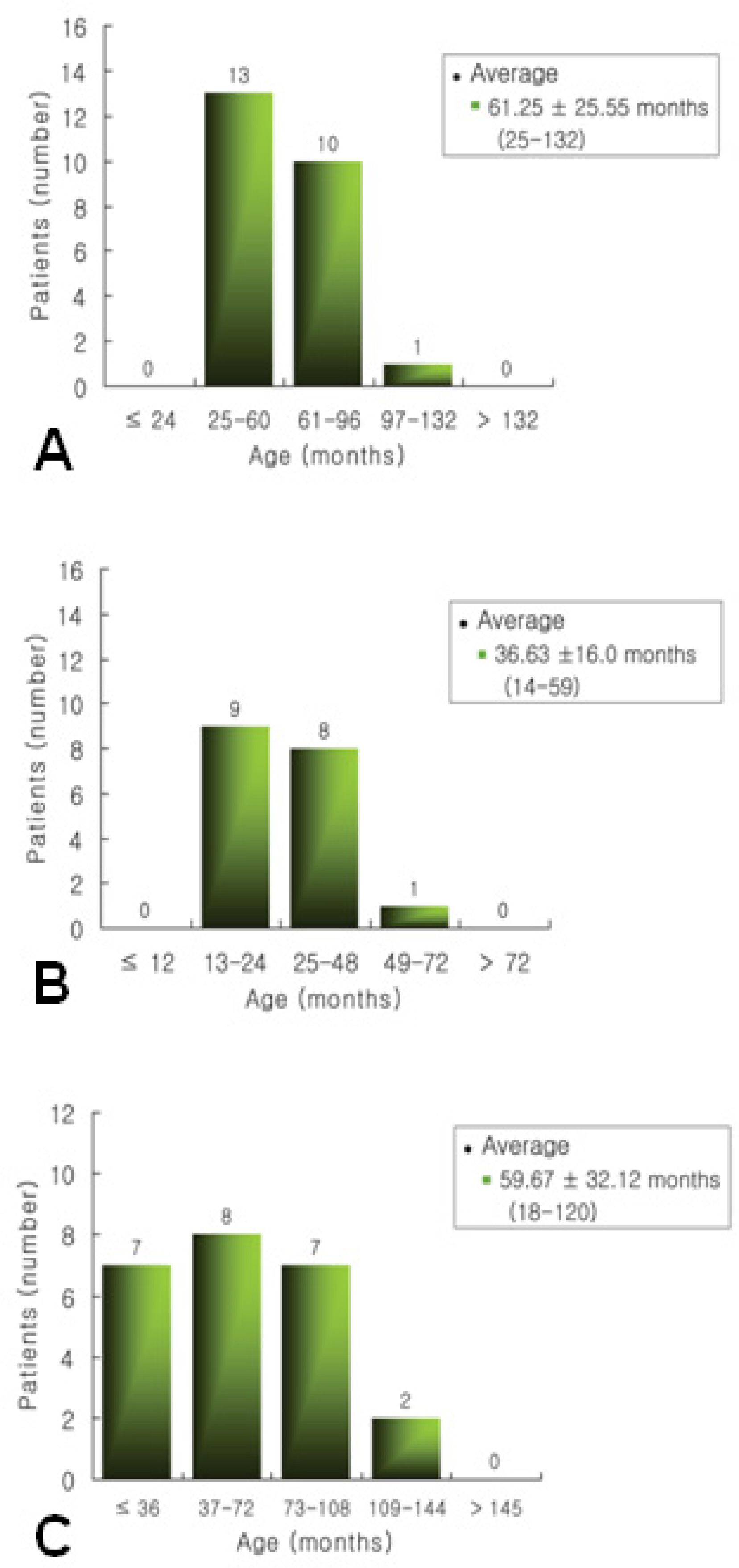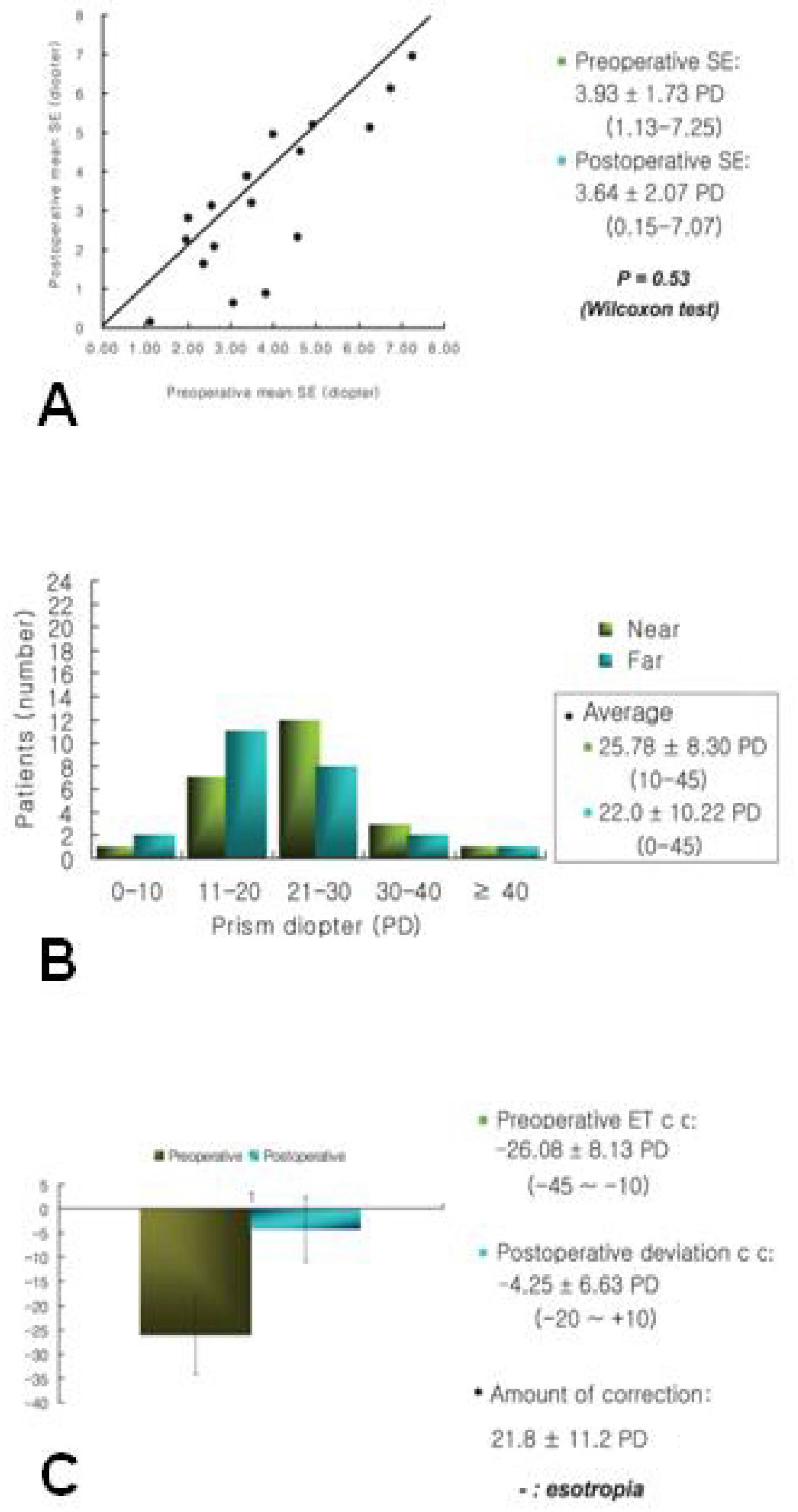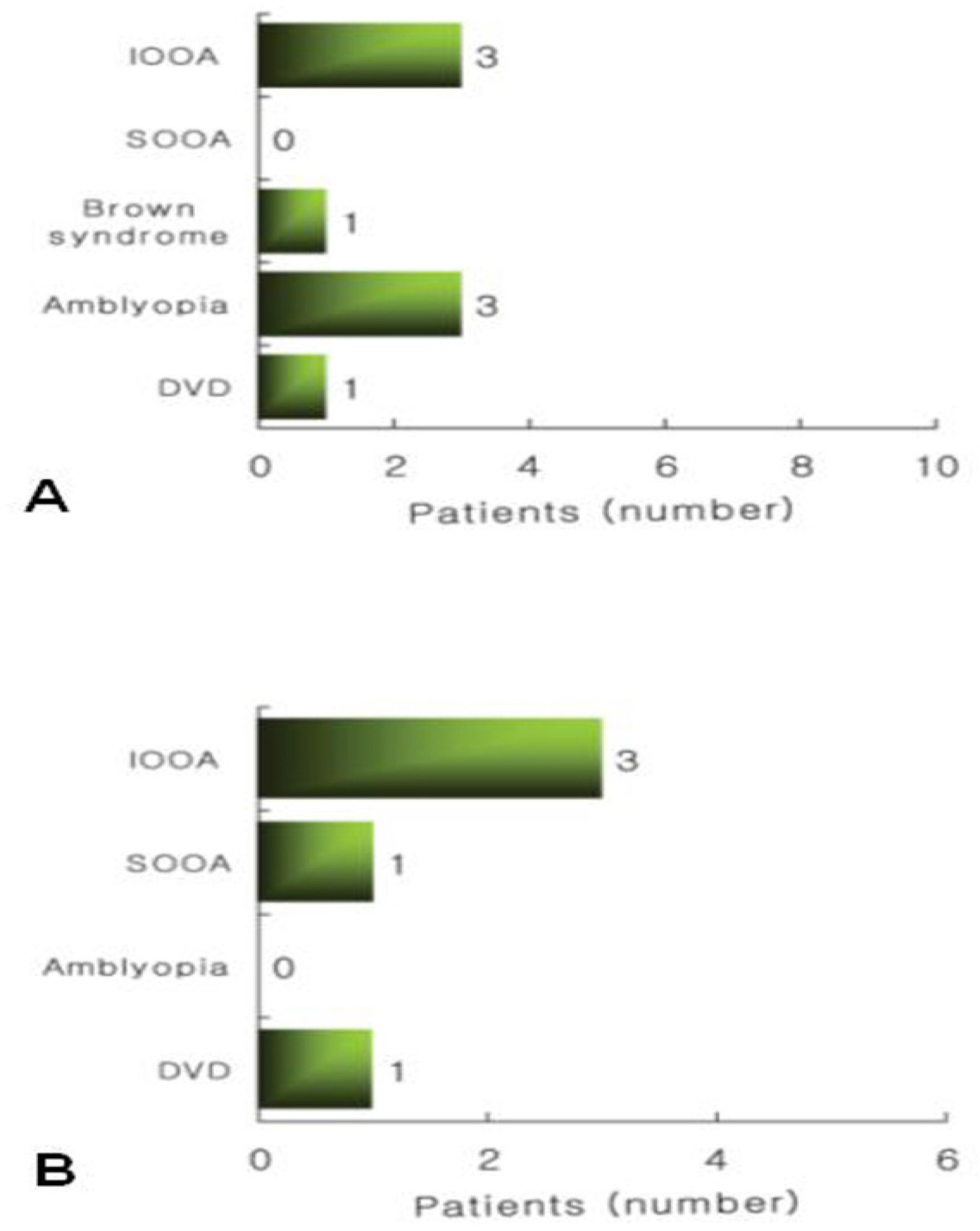J Korean Ophthalmol Soc.
2008 Apr;49(4):628-633. 10.3341/jkos.2008.49.4.628.
Long-term Follow-up Results of Partially Accommodative Esotropia After Near Geared Standard Surgery
- Affiliations
-
- 1Department of Ophthalmology, Chonnam National University Medical School and Hospital, Gwangju, Korea. Exo70@naver.com
- KMID: 2211495
- DOI: http://doi.org/10.3341/jkos.2008.49.4.628
Abstract
-
PURPOSE: To analyze the long-term outcome of near geared standard surgery with full hyperopic correction for
partially accommodative esotropia.
METHODS
The medical records of a total of 24 patients with partially accommodative esotorpia, who had undergone bilateral or unilateral medial rectus recession were retrospectively reviewed. The amount of medial rectus recession was measured based on the near deviation after full hyperopic correction. During the follow-up period the changes of refractive error and angle of deviation were evaluated, and the titmus test and Worth 4-Dot test were performed.
RESULTS
The mean ages were 36.63+/-13.38 months (14~59 months) at the time of wearing glasses and 61.25+/-25.55 months (25~132 months) at the time of operation. The average follow-up period was 59.67+/-32.12 months (18~120 months) and preoperative refractive errors were +3.93+/-1.73 D sph and refractive errors at final visit were +3.64+/-2.07 D sph (P=0.53). The mean amount of esodeviation were 26.08+/-8.13PD and 4.25+/-6.63PD for pre- and post-operatively respectively. Nineteen patients showed postoperative deviation of 10PD or less, one patient was overcorrected, and four patients were undercorrected. Worth 4-Dot test resulted in a fusion response at near and far in one patient preoperatively and in 17 patients postoperatively (P=0.30). A titmus stereotest of less than 100 seconds of arc resulted in 1 of 7 patients and 6 of 14 patients at the time of preoperation and postoperation each (P=0.34). The results were not statistically significant. Four of ten high hyperopic patients (> or = +4.00 diopter) had under- or over-correction (P=0.12), though it was not statistically significant. There were no significant differences in combined conditions.
CONCLUSIONS
Near geared standard surgery with full hyperopic correction in partially accommodative esotropia patients gave a good surgical result for patients in the mean follow-up duration of 59.67 months.
MeSH Terms
Figure
Reference
-
References
1. Von Noorden GK. Binocular vision and ocular motility. 6th ed.St. Louis: CV Mosby;2002. p. 319–20.2. Kim EJ, Cho YA. Clinical assessment of partially accommodative esotropia. J Korean Ophthalmol Soc. 1993; 34:447–51.3. Baker JD, Parks MM. Early-onset accommodative esotropia. Am J Ophthalmol. 1980; 90:11–8.
Article4. Arnoldi K. Long‐ term surgical outcome of partially accommodative esotropia. Am Orthopt J. 2002; 52:75–84.5. Jotterand VH, Isenberg SJ. Enhancing surgery for acquired esotropia. Ophthalmic Surg. 1988; 19:263–6.
Article6. Wright KW, Bruce-Lyle L. Augmented surgery for esotropia associated with high hypermetropia. J Pediatr Ophthalmol Strabismus. 1993; 30:167–70.
Article7. Prism adaptation study reseach group. Efficacy of prism adaptation in the surgical management of acquired esotropia. Arch Ophthalmol. 1990; 108:1248–56.8. Burian HM. Hypermetropia and esotropia. J Pediatr Ophthalmol Strabismus. 1972; 9:135–43.9. Parks MM. Abnormal accommodative convergence in squint. AMA Arch Ophthalmol. 1958; 59:364–80.
Article10. Bateman JB, Parks MM, Wheeler N. Discriminant analysis of acquired esotropia surgery. Predictor variables for short‐ and long‐ term outcomes. Ophthalmology. 1983; 90:1154–9.11. Ludwig IH, Parks MM, Getson PR, Kammerman LA. Rate of deterioration in accommodative esotropia correlated to the AC/A relationship. J Pediatr Ophthalmol Strabismus. 1988; 25:8–12.
Article12. Kim JC, Park SC, Park C. The Clinical effect of augmented surgery for partially accommodative esotropia. J Korean Ophthalmol Soc. 1995; 36:505–9.13. Kim YK, Kong SM. Augmented surgery for partially accommodative esotropia. J Korean Ophthalmol Soc. 2000; 41:2401–7.14. Choi AH, Park SG, Oh SY. Long‐ term outcome of patients with partially accommodative esotropia who had augmented surgery. J Korean Ophthalmol Soc. 2003; 44:1833–8.15. Dankner SR, Mash AJ, Jampolsky A. Intentional surgical overcorrection of acquired esotropia. Arch Ophthalmol. 1978; 96:1848–52.
Article16. Kushner BJ. Partly accommodative esotropia: Should you overcorrect and cut the plus? Arch Ophthalmol. 1995; 113:1530–4.17. Song JH, Seong YS, Chang YH, Lee JB. The long term surgical outcome after bilateral medial rectus muscle recession in partially accommodative esotropia. J Korean Ophthalmol Soc. 2004; 45:462–8.18. Yang H, Chang YH, Lee JB. Clinical features of refractive accommodative esotropia and partially accommodative esotropia. J Korean Ophthalmol Soc. 2004; 45:626–30.19. Lee J-Y, Kim JK, Cho YA. The longterm postoperative alignment and binocularity of partially accommodative esotropia. J Korean Ophthalmol Soc. 2000; 41:1974–82.20. Choi BR, Kwon J-Y. The long term follow-up results of patients with partially accommodative esotropia after conventional surgery. J Korean Ophthalmol Soc. 2004; 45:1865–71.
- Full Text Links
- Actions
-
Cited
- CITED
-
- Close
- Share
- Similar articles
-
- Long-Term Outcome of Patients with Partially Accommodative Esotropia Who had Augmented Surgery
- Clinical Assessment of Partially Accommodative Esotropia
- The Long-term Follow-up Results of Patients with Partially Accommodative Esotropia after Conventional Surgery
- The Long Term Surgical Outcome after Bilateral Medial Rectus Muscle Recession in Partially Accommodative Esotropia
- Clinical Features of Refractive Accommodative Esotropia and Partially Accommodative Esotropia




